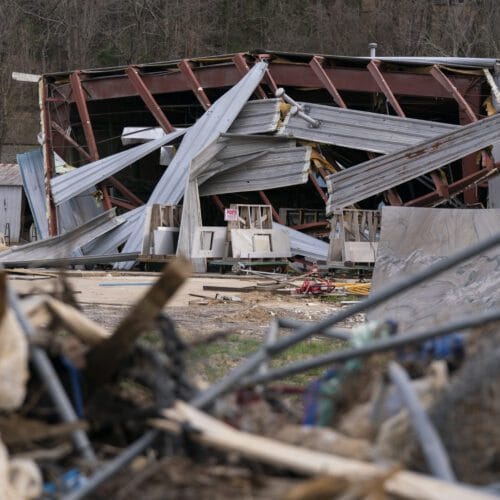
Recent natural disasters have underscored the vulnerabilities in America’s drug supply chain, particularly as climate change intensifies the frequency and severity of such events.
The Impact of Hurricane Helene
In September 2024, Hurricane Helene struck western North Carolina, causing widespread devastation and disrupting critical infrastructure. Among the facilities affected was Baxter International’s North Cove manufacturing plant in Marion, which produced sterile intravenous (IV) solutions. These solutions are vital for a variety of medical treatments, including rehydration, drug delivery, and kidney dialysis. The North Cove facility was responsible for an astonishing 60 percent of the U.S. supply of these essential fluids.
The immediate aftermath of the hurricane was severe. With the Baxter plant incapacitated, hospitals across the nation faced an acute shortage of IV solutions. This led to drastic measures, including rationing of supplies, alterations in treatment protocols, and in some cases, the cancellation or postponement of surgeries. A poll conducted during this crisis revealed that over 86 percent of healthcare providers reported being affected by the nationwide shortage of IV fluids. The ramifications of this shortage were felt across various healthcare settings, from emergency rooms to outpatient clinics, where the availability of IV solutions is critical for patient care.
Government Response
In response to the crisis, the federal government took swift action to mitigate the impact of the shortage. Regulatory agencies relaxed importation rules to allow for the quicker influx of IV solutions from foreign manufacturers. Additionally, the government extended expiration dates on existing supplies to maximize their usability. These measures, while necessary, highlighted the precarious state of the U.S. drug supply chain and raised questions about long-term sustainability.
The federal response also included coordination with state and local agencies to assess the situation and identify alternative sources for IV solutions. This collaborative approach aimed to ensure that healthcare providers had access to the necessary resources to continue treating patients effectively. However, these emergency measures underscored a critical vulnerability: the reliance on a limited number of manufacturing facilities for essential medications. The situation prompted discussions among policymakers about the need for a more resilient drug supply chain that could withstand such disruptions in the future.
Broader Context of Drug Shortages
The situation surrounding Hurricane Helene was not an isolated incident. Just months prior to the hurricane, the U.S. was already grappling with a record number of drug shortages. In early 2024, the number of active and ongoing drug shortages reached an all-time high of 323. Although this number has since decreased, it remains alarmingly high, with 253 shortages reported in the first quarter of 2025, according to data from the American Society of Health-System Pharmacists.
These shortages are not limited to IV solutions; they encompass a wide range of medications, including critical antibiotics, cancer treatments, and anesthetics. The reasons for these shortages are multifaceted, including manufacturing issues, quality control problems, and increased demand. However, the role of natural disasters and climate change cannot be overlooked. The increasing frequency of extreme weather events has compounded existing challenges in the drug supply chain, making it more difficult for manufacturers to maintain consistent production levels.
Climate Change and Drug Supply Vulnerability
Climate change is increasingly recognized as a significant factor contributing to the fragility of the drug supply chain. As extreme weather events become more frequent, the risk of disruption to manufacturing facilities grows. A report from the U.S. Government Accountability Office (GAO) indicated that a substantial number of drug manufacturing facilities are located in areas prone to natural disasters, including hurricanes, floods, and wildfires. This geographical vulnerability poses a significant risk to the continuity of drug supply.
According to the GAO report, approximately 40 percent of U.S. drug manufacturing facilities are situated in regions that are at high risk for natural disasters. This statistic raises critical questions about the resilience of the supply chain and the need for strategic planning to safeguard essential medications. The concentration of manufacturing in disaster-prone areas creates a single point of failure, which can lead to widespread shortages when disaster strikes. The implications of this vulnerability extend beyond immediate supply disruptions; they also threaten the overall stability of the healthcare system, which relies on a consistent supply of medications to function effectively.
Stakeholder Reactions
The implications of these vulnerabilities have prompted reactions from various stakeholders, including healthcare providers, policymakers, and pharmaceutical companies. Healthcare providers have expressed deep concern over the impact of drug shortages on patient care. Many have called for improved communication and transparency from manufacturers regarding supply chain risks and potential shortages. The frustration among healthcare professionals is palpable, as they often find themselves in difficult positions, having to make tough decisions about patient care due to medication unavailability.
Policymakers are also taking notice. In the wake of the Hurricane Helene crisis, several legislative proposals have emerged aimed at strengthening the resilience of the drug supply chain. These proposals include incentives for manufacturers to diversify their production locations and invest in backup systems to ensure continuity during emergencies. Additionally, there is a growing push for increased federal oversight of drug manufacturing facilities to ensure that they are adequately prepared for natural disasters. Such measures could help prevent future shortages and ensure that the healthcare system is better equipped to handle crises.
Pharmaceutical Industry Initiatives
In response to the ongoing challenges, some pharmaceutical companies are taking proactive measures to enhance the resilience of their supply chains. This includes diversifying manufacturing locations, investing in advanced technologies for production, and developing contingency plans for emergency situations. By spreading production across multiple sites, companies can mitigate the risk of a single facility being incapacitated by a disaster. This strategy not only protects the supply chain but also enhances the overall stability of medication availability.
Moreover, collaborations between pharmaceutical companies and government agencies are becoming more common. These partnerships aim to create a more robust framework for managing drug shortages and ensuring that essential medications remain available during crises. For instance, initiatives to establish stockpiles of critical medications and improve distribution networks are being explored as potential solutions to enhance supply chain resilience. Such collaborative efforts can lead to innovative approaches that address the complexities of drug shortages and improve the overall preparedness of the healthcare system.
Looking Ahead: The Future of the Drug Supply Chain
The challenges facing the U.S. drug supply chain are complex and multifaceted, but they are not insurmountable. As the frequency of natural disasters continues to rise due to climate change, it is imperative for stakeholders to prioritize the resilience of the drug supply chain. This includes not only addressing immediate vulnerabilities but also implementing long-term strategies to safeguard against future disruptions.
One potential avenue for improvement is the adoption of advanced technologies such as artificial intelligence and blockchain. These technologies can enhance supply chain visibility, improve inventory management, and facilitate real-time tracking of medications. By leveraging these tools, manufacturers and distributors can respond more effectively to disruptions and ensure that essential medications reach healthcare providers when they are needed most. Additionally, predictive analytics can help identify potential risks and allow for proactive measures to be taken before a crisis occurs.
Community Preparedness and Public Awareness
In addition to industry and government initiatives, community preparedness and public awareness play a crucial role in enhancing the resilience of the drug supply chain. Educating healthcare providers and the public about the potential risks of drug shortages and the importance of having contingency plans can help mitigate the impact of future disruptions. Public health campaigns aimed at raising awareness about the significance of maintaining adequate supplies of essential medications can also foster a culture of preparedness.
Furthermore, engaging community stakeholders, including local health departments and non-profit organizations, can create a more comprehensive approach to addressing drug shortages. By working together, these entities can develop strategies that not only focus on immediate needs but also promote long-term resilience in the healthcare system. This collaborative approach can lead to more effective responses to future challenges and ensure that communities are better prepared to face potential disruptions in the drug supply chain.
Conclusion
The fragility of America’s drug supply chain has been laid bare by recent natural disasters, highlighting the urgent need for comprehensive strategies to enhance resilience. As climate change continues to pose significant risks, stakeholders across the healthcare spectrum must work collaboratively to address vulnerabilities and ensure that essential medications remain accessible to those in need. By prioritizing preparedness, investing in technology, and fostering community awareness, it is possible to build a more robust drug supply chain that can withstand the challenges of the future.
Source: Original report
Was this helpful?
Last Modified: September 6, 2025 at 3:52 am
5 views















